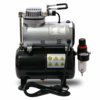OK, a few temperature measurements today. Here is the airplane as it sits in the hangar:

I'll call the blades 1, 2, and 3 starting from the left (so 2 is the vertical blade). As you can see, blades 1 and 3 are partially covered on the front face with the blanket, while blade 2 is mostly uncovered.
The temperature measurements were a little weird to me, especially on blade 3. I measured the temp of each blade at the tip, roughly mid-span just outboard of the blanket, and at the root. OAT (well, not outside, but in the hangar) was in the low 50s. The following were the measurements:
Blade: Tip, Mid-span, Root (ºF)
1: 54, 65, 80
2: 56, ??, 77 (didn't measure mid-span because it wasn't covered with a blanket... But I probably should have.)
3: 58, 60, 78
What I found surprising was that the #1 blade had an 11º difference between tip and mid-span, while the #3 blade was only a 2º difference. It would seem that maybe heat conduction is better on the #3 blade, because its tip was warmer and its middle was cooler?
In any case, clearly there is plenty of heat loss happening through the prop.
For other measurements - I aimed it as far in just behind the spinner as I could, and got a reading of 94ºF. The #5 cylinder was 125ºF, the #6 cylinder 135ºF, and aimed down the filler tube into the sump I got a reading of 148ºF!
I didn't think to measure it right away after removing the blanket, but a couple minutes later I measured the exterior of the cowl: 56º near the bottom on the exposed portion, 84º at the top under where the blanket was. I also measured the right-hand exhaust pipe, which was 50º at its tip (basically OAT), and 53º where it comes out of the cowling. I was expecting this to be somewhat higher, but I guess the metal is much thinner and it's farther from the heat sources, so conduction isn't helping it nearly as much as it does at the prop.
It would be interesting to see what all these measurements were on the coldest day of winter. Even the prop was well above the dewpoint today, but I'm wondering if that would still be the case on an exceptionally cold day.




